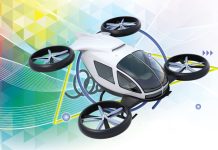Electric aircraft maker Lilium has announced a $US90 million investment that it says will allow them to have autonomous electric flying vehicles in operation by 2025.
‘The investment will be used for the development of the five-seat Lilium Jet that will fly commercially, as well as to grow our current team of more than 70,’ Lilium said.
Lilium flew its prototype vehicle this year. The design uses up to 36 ducted fans, mounted in boxes which rotate between vertical and horizontal thrust. The vehicle takes off vertically and transitions to fixed wing flight like a tilt-rotor aircraft. Lilium says its layout generates lift from the wings, even in vertical take-off mode. The company says its Lilium Jet will be able to travel at up to 300 km/h (162 kt) for one hour on a single charge. It is intended to fly autonomously, with no pilot’s controls.
Lilium was founded in 2015 by four academics at the Technical University of Munich and has grown into a company employing more than 70 engineers. The company recently joined the US General Aviation Manufacturers’ Association (GAMA). It describes its mission as ‘to make air taxis available to everyone and as affordable as riding a car’.






Hahaha now that’s funny!! Never gunna happen in in that time frame! Who would insure such a crazy idea?…..next please! -:)
Clearly they have no idea as to what certification costs, USD $90m to develop and certify an autonomous person carrying aircraft won’t even scratch the surface; yes, they may have other funding, but it better be in the range of an order of magnitude more to pull this off. Then let’s look at the concept, lots of small EDFs is incredibly inefficient when compared to larger FSA propulsion technologies. A back of the envelope calculation, 5 Pax, airframe, propulsion, batteries, let’s say 1000kg, therefore, each EDF needs to develop ~30kg of thrust allowing for some control margin. At current technologies and assuming the artist’s impression is somehwat accurate and the EDFs are around 250mm diameter, to produce 30kg from each EDF at a very high disc loading of ~600kg/m2 requires ~ 20kW per fan. Therefore, some 720kw at TO! Then there is level flight for 1 hour at 162kts, even assuming a substantial efficiency increase in level flight over vertical takeoff, these small EDFs will still consume in the order of 240kw total, so all up maybe 300kwh of battery needed. At current energy densities that’s over 2000Kg of batteries – oh that’s right, our calculations were based on 1000kg TOW, so here we go in the death spiral of low propulsion efficiency, and the relatively low energy density of batteries versus hydrocarbon fuels; if you do a comparison to conventional helicopter power requirements for 5 seats you will soon see why this is the dot.com boom all over again.
Have to agree there Walter.Another crazy idea,designed to excite the masses,and to fill the pages of scientific journals,When will they ever learn.And your dead right,who would insure it.
Should be pink, with a curly tail !
Such “clever” comments from the smarties. Think about it, of course they will raise more money and it will not be easy and will take longer but at least they are doing it. Lets support them, I will, the future is out there.
No problem with start ups based on sound engineering concepts, however, I have seen far too many Mum and Dad investors lose their money supporting far fetched concepts being promoted by enthusiastic but incredibly naive “inventors”. Yes there is a future for electric flight, but not starting with inherently inefficient platform concepts, there are already enough challenges without handicapping the project from the start.